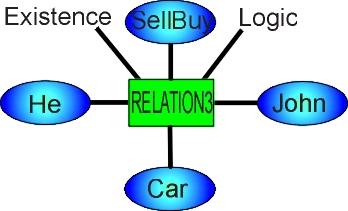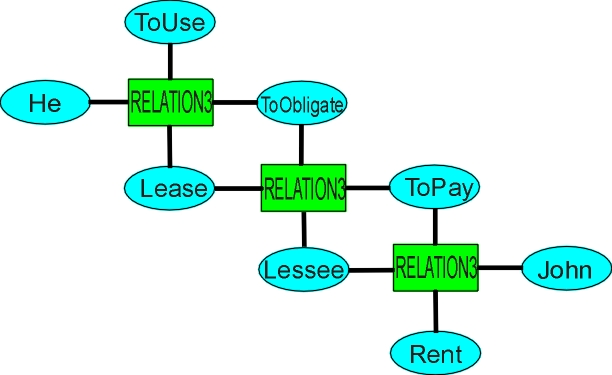Extension to Active Structure to Handle Free Text
We describe the extensions necessary to enable active structure to handle free text in scientific and legal documents. These extensions are relevant in many other areas, such as information fusion and DSS.
Detailed Structural Existence
In the simple form of active structure, the existence of an equation or inequation like A + B = C can be controlled at the level of the statement by controlling its connection to the logical spine. Where there are complex relations – "the option to extend the lease" – existential control needs to be exercised over the individual relations – each relation needs both a logical and an existential connection. This isn’t just to represent the structures and states implicit in free text, but also to more precisely describe the basis for a decision. The option may have expired or the lease terminated for breach – words for relations carry dense information. We can have relations with both logical and existential connections, but there is a strong relation between the two connections – a relation can’t be true if it does not exist, and it can’t be logically truer than its existence value – "If I can pay you, I will". You can see what happened here – we took the existential truth value of the To Pay relation and used it as the antecedent, with the consequent the logical truth value. The relation operator maintains the necessary logical relation between its two truth states. All of the logical connectives (AND, OR, IF) need to be able to accept any mixture of existential and logical states, because we as humans cannot be bothered doing something so obvious.
See Existence Logic
Extensions to Logic
ORION had all the usual logical operators - IF, IFF, AND - but free text demands more - BUT, BECAUSE. BUT is interesting - it may be a simple AND ("I want it more than 2 metres but less than six metres") but can also be an AND with the ability to clear inconsistencies (and require dependent connections to be made between the structures it is joining).
Temporal Structure
If the system has control over existence, then it becomes important to be able to represent when an object or relation was created, when it was destroyed, how long it may survive. Most relations inherit durations, while some relations instantaneously create and destroy other relations – "He started working at the bank last week", "The bridge was destroyed by fire". The figure shows the temporal structure of an "occupy" relation (top left corner - a relation either inherits or has a component - COMPONENTS operator - of Time Period, which inherits or has attributes of Start Date, Finish Date and Duration).

Relations as Objects
The notion that objects and relations are different things comes from the evolution of the concept of objects from programming languages, with their strong dichotomy between locations and operations. In the real world, the one we talk about, we know that a lease is a relation among a lessor, a lessee and property, a car is an assembly relation on its components, a process is the doing of something. If we allow relations to be objects in our formalism, then we have a much more coherent and general representation of the world. Relations acquire properties by inheritance in the same way as other objects, but they also have parameters, which may be relations.

The diagram shows a relation, ToSell/ToBuy, and its parameters, or the things it relates. The relation operator has a head object, which allows the relation to be an instance of a base relation, to inherit properties and be connected as a parameter to other relations to form chains of relations. The relation also has explicit existential and logical connections, things the simpler form of the PLUS operator lacks. Non-arithmetic relations in general require a specific existential connection – the system may need to signal the difference between "the buyer could not..." and "the buyer did not..." just as much as we need to do in speech. The connections can be stubs - "He sold the car to John" - the ToSellBuy relation has a true logical state, which means its existential state is true and can be stubbed. Joining buyer and seller together with the object being sold in the one transaction relation should make it clear how a more complex and general representation of a relation can reduce the length of inferential chains, and represent many different nuances on the one transaction, using temporal control over the existential and logical connections –
He sold/has sold/is selling/will sell/may sell a car to John
He did not/could not/would not/should not sell a car to John
John bought/is buying/may buy a car from him.
See Relations
Object Groups
We can give any grouping of objects properties, which are then inherited by the members of the group – "the team won" – the members are winners too. This works both ways – if we can show that every member of the group has some property, and the group can have that property, then the object group acquires that property. With relations as objects, we can make them into object groups as well - "Jack fell down and broke his crown" - the ToFall and ToBreak relations become an object group. Inheritance through groupings is surprisingly important.
See Object Groups
Computable Inheritance
Making relations objects and allowing them to acquire properties through inheritance greatly increases the density of the inheritance structure. We cannot assume the inheritance structure is static or known a priori. We should expect different contributions to the knowledge to have different views on the inheritance structure, requiring it to be dynamic. Frequently, disambiguation will turn on changing the location of the connection of an object into the inheritance structure. Two situations arise where inheritance may not be fully known. One is where an object is part of another complex object, but we are unsure which part. "Part of the building is on fire". Until we know more about the "part", it needs to inherit all the divisible properties of the building (the street address is a non-divisible property, and would not be inherited, but would be discoverable) and any (combustible) component, and we need to interpose some control over the inheritance path, initially allowing alternatives and pruning them as we learn more. A related case is where we know an object is a member of a group, but we don’t know which member. We are told a member of staff is to receive an award. That member has potentially acquired the individual properties of every staff member. We are then told the person is female, sloughing off many possible properties ("not the janitor"), and so on. Under some circumstances, inheritance needs to be controlled, does not just come from above in the hierarchy, and the methods of constraint reasoning are used to aid in narrowing the possibilities.
See MEMBERGROUP
Relations on Relations
Here is an example – "the option to extend the lease" – there are three relations, all in a row. If human intention is involved, a whole new layer of relations is added – "he thought he needed to exercise the option to extend the lease" (in this case, the statement is incomplete, as it is the term of the lease that is extended, and it is assumed that the option exists, but it is not activated by this structure). With existential control on relations, and seeing relations as objects, relations on relations is easily handled. A relation on relation structure to any depth is built by connecting the relation objects and their parameters, which may be relation objects. In AI, we have struggled without this facility for a very long time.

He used the lease to obligate the lessee to pay rent to John
Existential, logical and inheritance links are not shown in the diagram.
Active Maps
Sometimes extension of a structure requires the bringing of some other structure to the site, the temporary connection of it to the structure it finds there, the construction of some new structure, the disconnection of the temporary connections. If this sounds like scaffolding, it is a close analogy but not a complete one - there is considerable organisation in the structure brought to the site to do the construction. An example is building a bridge across a canyon. You can start building from one side, oblivious of the other side so you have no idea how it has to be built, or you can build from both sides towards each other.
Prepositions are a good example - "he cut the rope with a knife", "he cut the rope with care", "he cut the rope with seconds to spare" - the structure brought to the site has to work out what to build depending on what it finds. It may be joining considerable structure on both sides. This is a particular skill of humans, and needs to be reproduced in some form to handle free text.
Diffuse Operators
A relation can obtain its time attributes - start time, finish time, duration - by inheritance, by explicit statement, or by inference from other relations. To calculate these attributes, a diffuse operator is used - an operator which builds its own connections.
Constraint Reasoning
Constraint reasoning has been used in Active Structure for a long time. It has ben necessary to extend constraint reasoning as well - giving it the ability to add alternatives to an object in a particular context, not just prune the ones handed out at the start. An analogy is handing out grenades - you can give them to everybody, or only to soldiers going into battle - doing it that way minimises blowups. Some words, such as "that", have so many possible meanings that handing them all out at the beginning has a disastrous effect on parsing. Constraint reasoning is also used to make and change connections, allowing meanings to become more precise as more is known.
A Package
The ability to actively represent relations on relations relies on existential control of individual relations, on relations being conceptualised as objects, so they may be part of the inheritance hierarchy, and on relations inheriting a component of time period, which determines existence. These properties of the structure are not divisible into separate properties which can be added individually – they support each other, and need to be added together, to provide an integrated whole.
See